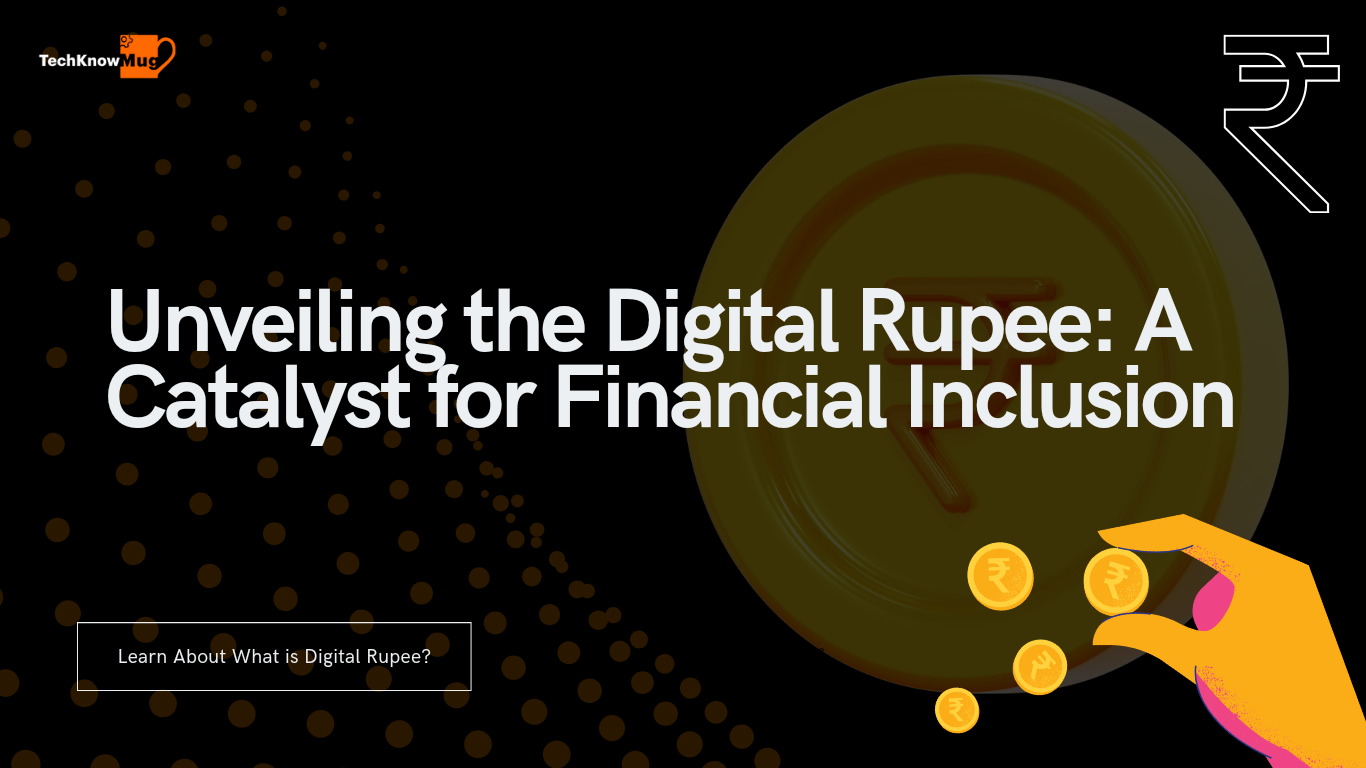
The Digital Rupee, a groundbreaking initiative in the realm of digital currencies, aims to revolutionize traditional finance by seamlessly integrating technology into our monetary system.
Understanding What is Digital Rupee? | CBDC
The Digital Rupee is a central bank digital currency (CBDC) issued by the Reserve Bank of India, designed to exist in electronic form. Unlike physical currency, it operates on a blockchain or a similar distributed ledger technology, ensuring transparency and security.
Digital Rupee refers to a form of digital currency issued by the central bank of a country, essentially a digital representation of the national currency. It operates on a blockchain or distributed ledger technology, providing a secure and transparent method of conducting financial transactions. The concept of a Digital Rupee aligns with the broader global trend of central banks exploring the possibilities of central bank digital currencies (CBDCs).
One key feature of the Digital Rupee is its digital nature, eliminating the need for physical cash. Users can store and transact with this digital currency using electronic devices, such as smartphones or computers. This shift towards digital currencies aims to enhance the efficiency, security, and accessibility of financial transactions.
Central banks are motivated to explore digital currencies for various reasons. Firstly, it allows for better control and monitoring of the money supply, as transactions can be tracked in real-time. This helps in implementing effective monetary policies. Additionally, a Digital Rupee can reduce the reliance on physical currency, leading to cost savings in currency production and distribution.
Security is a paramount concern in the development of Digital Rupee. The underlying blockchain technology ensures that transactions are secure, transparent, and resistant to fraud. Encryption techniques play a crucial role in protecting user data and maintaining the integrity of the digital currency system.
Moreover, the Digital Rupee aims to foster financial inclusion by providing access to digital financial services to a wider population. With a simple smartphone, individuals can participate in the digital economy, making transactions, accessing banking services, and even saving money digitally.
It’s important to note that the development and implementation of a Digital Rupee involve careful consideration of regulatory frameworks and collaboration with various stakeholders, including financial institutions, technology providers, and policymakers. Central banks need to strike a balance between innovation and ensuring the stability and integrity of the financial system.
How Does Digital Rupee Work?
Digital Rupee, or a digital version of the Indian rupee, would function as a central bank digital currency (CBDC). Here are some key points on how it might work:
- Centralized Authority: The digital rupee would be issued and regulated by the Reserve Bank of India (RBI), making it a centralized form of currency.
- Digital Wallets: Users would need a digital wallet to store and transact with digital rupees. These wallets could be provided by authorized financial institutions or directly by the central bank.
- Account-based System: The digital rupee would likely be linked to individuals’ bank accounts, creating a direct connection between the digital and traditional banking systems.
- Legal Tender: The digital rupee would have the same legal status as physical cash, allowing it to be used for all transactions within the country.
- Peer-to-Peer Transactions: Users can make peer-to-peer transactions using their digital wallets. This could be done through mobile apps or other electronic devices.
- Offline Transactions: The design may allow for offline transactions to some extent, ensuring that people can transact even in areas with limited internet connectivity.
- Smart Contracts (Possibly): Depending on the technology used, the digital rupee might support smart contracts, enabling self-executing contracts with the terms of the agreement directly written into the code.
- Privacy Features: The system would likely have privacy features, balancing the need for user privacy with the regulatory requirements for preventing illicit activities.
- Regulatory Compliance:
The digital rupee would be subject to the same regulatory framework as physical currency, with measures in place to prevent money laundering, fraud, and other financial crimes. - Cross-Border Transactions: It could potentially simplify cross-border transactions and trade by reducing the reliance on intermediaries and facilitating faster and more cost-effective transfers.
Here Are Some Advantages of the Digital Rupee
- Reduced Transaction Costs: The digital rupee streamlines financial transactions, minimizing the costs associated with traditional banking methods.
- Financial Inclusion: It opens up banking services to a wider population, allowing those without access to traditional banking to participate in the digital economy.
- Enhanced Security: Digital transactions with the rupee benefit from advanced encryption and security measures, reducing the risks associated with physical currency.
- Efficient Cross-Border Transactions: Digital rupee facilitates quicker and more cost-effective cross-border transactions, eliminating the need for multiple intermediaries.
- Transparency and Accountability: Blockchain technology, often used in digital currencies, ensures a transparent and tamper-proof ledger, fostering accountability in financial transactions.
- Monetary Policy Implementation: The digital rupee provides central banks with additional tools for implementing monetary policies effectively.
- Promotion of Innovation: The adoption of a digital currency encourages innovation in financial services and technology, leading to the development of new solutions and products.
- Faster Payments: Digital rupee transactions can occur in real-time, enabling faster and more convenient payment processes for individuals and businesses.
- Reduced Cash Dependency: A digital rupee can help decrease reliance on physical cash, potentially reducing issues related to counterfeit currency and illicit transactions.
- Smart Contracts and Automation: Integration of smart contracts allows for automated and self-executing agreements, enhancing efficiency in various financial processes.
Difference Between Digital Rupee and Cryptocurrency
Digital rupee is a centralized digital currency issued by a government, maintaining a direct link to the country’s official currency. In contrast, cryptocurrencies are decentralized and operate on blockchain technology, independent of any central authority. While digital rupee aims for stability and government control, cryptocurrencies prioritize decentralization and anonymity, often driven by technologies like blockchain and smart contracts.
Some Key Points Between Digital Rupee & Cryptocurrency Is:
(Digital Rupee vs. Cryptocurrency)
Centralized vs. Decentralized: Digital Rupee is typically centralized and controlled by the government or a central authority, whereas cryptocurrencies operate on decentralized blockchain technology, eliminating the need for a central governing body.
Legal Tender: Digital Rupee is recognized as legal tender by the government, backed by its authority, while cryptocurrencies like Bitcoin aren’t universally recognized as legal tender and their acceptance varies.
Control and Regulation: Governments usually have greater control over a digital rupee, allowing for regulation and intervention when necessary. Cryptocurrencies, being decentralized, often operate beyond direct government control.
Anonymity: Cryptocurrencies can offer a higher degree of user anonymity compared to digital rupee transactions, which are subject to more stringent identification and verification processes.
Value Stability: Digital Rupee values are typically stable and tied to the national currency, providing a level of predictability. Cryptocurrencies, on the other hand, are known for their price volatility, influenced by market demand and speculation.
Transaction Speed and Cost: Digital Rupee transactions may be faster and have lower fees due to centralized infrastructure. Cryptocurrency transactions can vary in speed and cost, influenced by network congestion and the chosen cryptocurrency.
Purpose and Use Cases: Digital Rupee is often designed for everyday transactions within a specific country, while cryptocurrencies can serve various purposes, including cross-border transactions, smart contracts, and as a store of value.
Technology Infrastructure: Digital Rupee relies on traditional banking infrastructure, whereas cryptocurrencies utilize blockchain technology, enabling secure and transparent peer-to-peer transactions without intermediaries.
Inherent Value: Digital Rupee derives its value from the backing of the government and its economy. Cryptocurrencies derive value from factors like scarcity, utility, and market demand.
Global Recognition: Digital Rupee is recognized within the issuing country, while cryptocurrencies operate on a global scale, transcending borders and national boundaries.
Watch Video On How to use e-Rupee in Hindi | Digital Rupee App Tutorial
Conclusion
In conclusion, the Digital Rupee not only represents a technological leap in the financial landscape but also serves as a powerful tool for promoting financial inclusion. By leveraging blockchain, reducing transaction costs, and empowering the unbanked, it plays a pivotal role in creating a more inclusive and accessible financial ecosystem.
